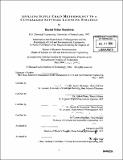| dc.contributor.advisor | Sara L. Beckman and Abbott Weiss. | en_US |
| dc.contributor.author | Sheinbein, Rachel Felice, 1975- | en_US |
| dc.contributor.other | Leaders for Manufacturing Program. | en_US |
| dc.date.accessioned | 2006-11-08T16:37:01Z | |
| dc.date.available | 2006-11-08T16:37:01Z | |
| dc.date.copyright | 2004 | en_US |
| dc.date.issued | 2004 | en_US |
| dc.identifier.uri | http://hdl.handle.net/1721.1/34781 | |
| dc.description | Thesis (M.B.A.)--Massachusetts Institute of Technology, Sloan School of Management; and, (S.M.)--Massachusetts Institute of Technology, Dept. of Civil and Environmental Engineering; in conjunction with the Leaders for Manufacturing Program at MIT, 2004. | en_US |
| dc.description | Includes bibliographical references (p. 76). | en_US |
| dc.description.abstract | Eleven percent of companies spend between $150K and $200K per year per engineer on software development tools and nine percent spend more than $200K, according to a Silicon Integration Initiative/Gartner/EE Times study from 2002. For Agilent Technologies, these costs result in spending tens of millions of dollars each year on software, and for Motorola, the costs are more than $100M each year. From the current trends in software spending, one can infer that companies will pay even more for software in the future, because the cost of the software itself is rising and because of the complexity of the technology needed for innovation. In order to understand whether the total spending on software is appropriate and necessary, Agilent sponsored this project to create a model that analyzes the trade-offs between the cost of software and the cost of software unavailability. The model treats software licenses as supplies to the development of a product, and thus, supply chain methodologies such as inventory (cost of licenses), stock outs (cost of unavailability) and service level are applied. The goal of the model is to minimize software costs while maintaining a satisfactory level of service. The thesis explains the model and then shows the results from applying it to four software products that Agilent currently uses. The results show that in the absence of this type of analysis, Agilent spends more than necessary for software licenses. In fact, Agilent can reduce costs by at least 5%. This model can be used by Agilent and other companies to optimize software purchases. | en_US |
| dc.description.statementofresponsibility | by Rachel Felice Sheinbein. | en_US |
| dc.format.extent | 76 p. | en_US |
| dc.format.extent | 3926643 bytes | |
| dc.format.extent | 3926449 bytes | |
| dc.format.mimetype | application/pdf | |
| dc.format.mimetype | application/pdf | |
| dc.language.iso | eng | en_US |
| dc.publisher | Massachusetts Institute of Technology | en_US |
| dc.rights | M.I.T. theses are protected by copyright. They may be viewed from this source for any purpose, but reproduction or distribution in any format is prohibited without written permission. See provided URL for inquiries about permission. | en_US |
| dc.rights.uri | http://dspace.mit.edu/handle/1721.1/7582 | |
| dc.subject | Sloan School of Management. | en_US |
| dc.subject | Civil and Environmental Engineering. | en_US |
| dc.subject | Leaders for Manufacturing Program. | en_US |
| dc.title | Applying supply chain methodology to a centralized software licensing strategy | en_US |
| dc.type | Thesis | en_US |
| dc.description.degree | S.M. | en_US |
| dc.description.degree | M.B.A. | en_US |
| dc.contributor.department | Leaders for Manufacturing Program at MIT | en_US |
| dc.contributor.department | Massachusetts Institute of Technology. Department of Civil and Environmental Engineering | |
| dc.contributor.department | Sloan School of Management | |
| dc.identifier.oclc | 56722135 | en_US |
